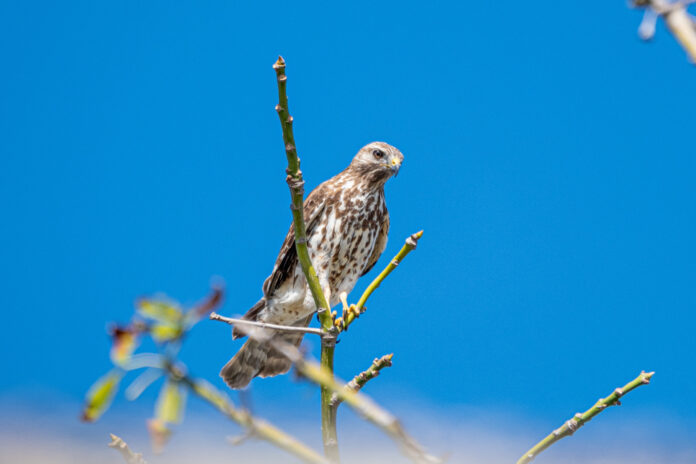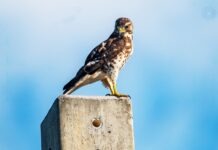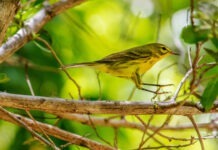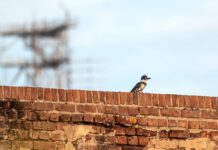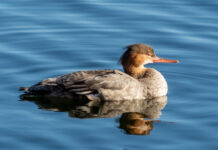Red-shouldered hawks are the car alarms of the raptor world, always going off and making a racket for reasons unclear. At least, this is how it felt to me recently.
My wife and I just road-tripped up to north Florida for a friend’s epic birthday party. (Damn, Tracey Holst, you make 60 look good.) Afterward, my wife beelined back to Key West with a friend and I spent a couple days wandering around Florida backroads, working on a photo project.
I drove about 2,500 miles, by rough estimation, and I wasn’t really looking for birds. But every third or fourth time I got out of the truck, I’d hear a red-shouldered hawk screaming its fool head off, a loud kee-YA, kee-YA, kee-YA, that comes off as exactly the kind of sound you expect a hawk to make if you were making up the call from your imagination. (The most straight- from-central-casting raptor call is the red-tailed hawk, which is so much what you expect to hear from a bird of prey that it is often used to dub the call of the bald eagle, because the real-life bald eagle call sounds kind of wussy.)
Winter is apparently breeding season for red-shouldered hawks in Florida. This time of year they could be building nests or sitting on eggs. It’s still a little early for hatching. But whenever I heard a red-shoulder going off on this trip, I would look around for a predator like a crow, or another hawk, or an owl, and there was nothing to be seen.
There’s that line from “To Kill A Mockingbird” when Miss Maudie, the housekeeper, says it’s a sin to kill a mockingbird because “they don’t do one thing but sing their hearts out for us.” Which maybe is what’s been going on with the red-shoulders, though I think maybe they weren’t singing their hearts out for us, but just for the hell of it. Maybe their singing, like opera or Tori Amos, is an acquired taste.
Often, it feels if you try to generalize about birdlife in Florida, the Keys end up requiring an asterisk. (Actually, most times, if you try to generalize about anything in Florida, the Keys end up requiring an asterisk.) But the red-shouldered hawk mostly evades that asterisk, as they are pretty common in the Keys. South Florida actually has its own subspecies of red-shouldered hawks, Buteo lineatus extimus, which is paler and smaller than other red-shoulders.
I see them pretty regularly in Big Pine, Big Torch and the backcountry islands. The Florida population doesn’t migrate, which makes them the one hawk that you can reliably find in the Keys year-round.
The one place they are rare? Key West.
I’m not sure why they eschew Key West proper. Red-shoulders are known to breed in suburban and urbanized areas, sometimes nesting as close as 6 feet from a building and 3 feet from a highway.
In one species account I read from 1930, the author described all the various ways he went about trying to disturb red-shoulders from their nests.
“After the bird has deposited her full set (of eggs) she is always found on the nest, and rarely slips off until the tree is smartly rapped, or loud shouts are given, or sticks thrown up at the nest.
“She is often a close sitter and even this does not seem to bother her. I have thrown sticks and had them strike the nest only to have her flit up, and again settle upon the eggs. Often after rapping you are forced to ascend, and then sometimes she leaves the nest softly as an owl, but more often emits wild piercing screams. I once went up to a nest on a windy day and touched the bird’s tail once and still she remained. The second time she dashed off like a bullet,” wrote Donald J. Nicholson in the Wilson Bulletin, one of the premier ornithological journals of the era (and today).
“One day I visited five nests, and the first bird carried away my cap in her talons and struck me such a severe blow that it gave me a bad headache, and left a scratch on my forehead. At two more nests I was attacked and struck upon the head. Many other times this has happened.
“This bird coming swiftly as an arrow directly for your head, screaming wildly, gives a timid soul the shivers, and unless you wildly wave your arms and shout. most likely she will give you a stiff blow that will put fear into you, and respect for their bravery,” Nicholson continued.
Ornithological methods have changed since then, and just to be clear, harassing a bird like that is absolutely wrong in modern times, and was pretty wrong then. Also illegal. But it does go to show that red-shoulders are no shrinking violets, and not shy of humanity. Which makes you think they could thrive in Key West, especially with the seemingly never-ending supply of doves, pigeons, free-roaming poultry, and young iguanas. But no. They decline to breed here.
Which is not to say I’ve never seen a red-shoulder in Key West. I saw one from a boat in Key West Harbor once, circling slowly in the breeze, the translucent panels at the outer edges of the bird’s wing glowing when it was backlit.
And once, in what was perhaps my favorite sighting of a red-shouldered hawk ever, I saw one perched in the top of the giant kapok tree in front of the Harvey Government Center at the corner of Truman Avenue and White Street. I was pumping gas at the Dion’s when I saw it. I grabbed my binoculars at first, then caught a few frames with my camera. Despite all the rumbling trucks and honking scooters and incoming airliners, it stayed for quite a while, slowly surveying the world below, giving no clue about what it found to be unsuitable about this last little bit of old Florida.















